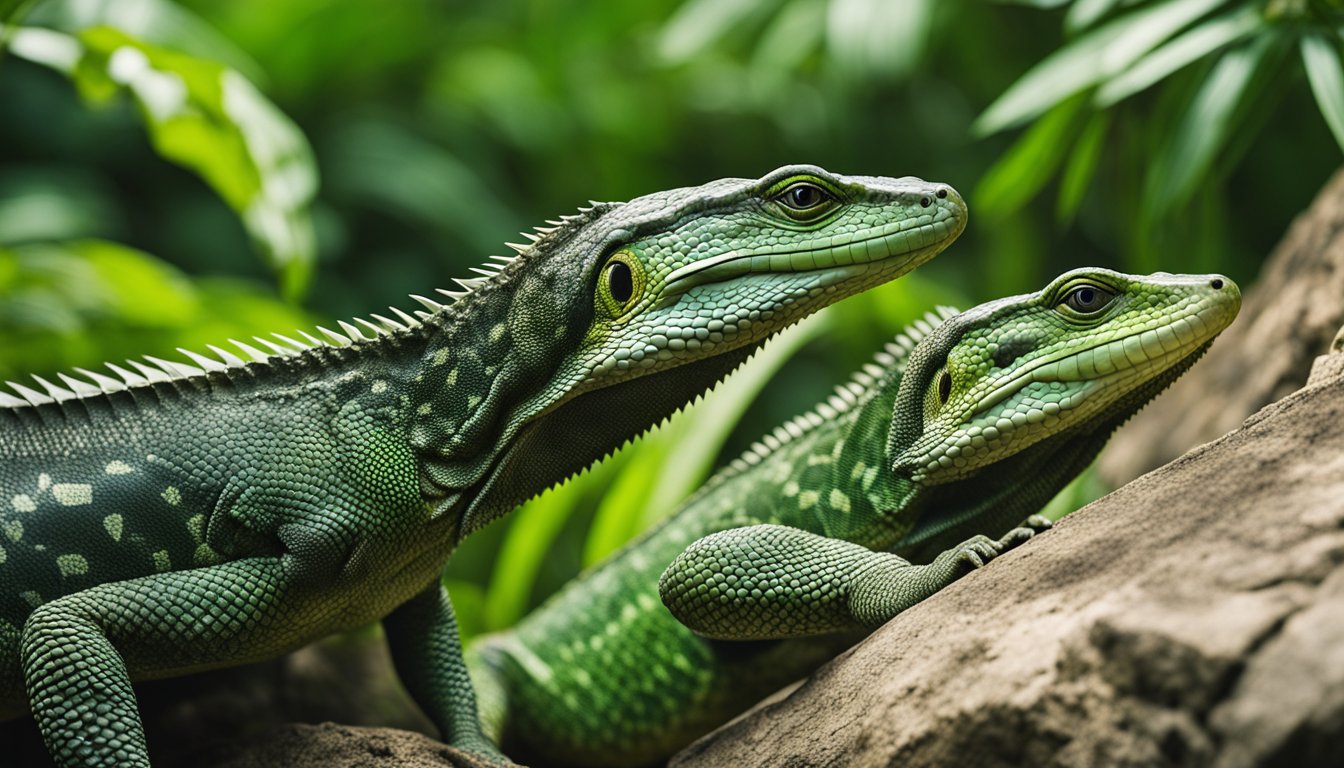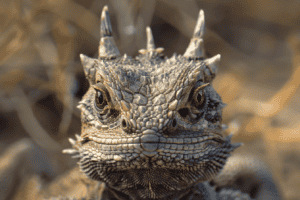Monitor lizards are fascinating creatures that roam our planet, showcasing the raw beauty and diversity of wildlife.
With their long, muscular bodies, powerful tails, and sharp claws, these reptiles are well-equipped for a life of predation.
Imagine walking through a tropical forest and spotting a monitor lizard basking in the sun or hunting through the underbrush.
These reptiles are not only impressive in appearance but also in their range of behaviors and skills that enable them to thrive in various environments.

Kids might be surprised to learn that monitor lizards come in many sizes.
The famous Komodo dragon, for instance, can grow to be as long as a small car, making it the largest of its kind!
While these giants are truly mighty, other monitor lizards may only grow to be as long as a ruler.
These creatures are superb survivors, adapting to life in different habitats such as forests, deserts, and even waterways.
Their diet is just as diverse as their homes, including insects, birds, and even larger mammals, showing their prowess as skilled predators.
What do you think it takes for a monitor lizard to catch its next meal? Speed, stealth, and precision are part of their hunting toolkit.
They use their forked tongues to “taste” the air, tracking down their next snack with a sense of smell that’s incredibly acute.
And here’s a fun fact: some monitors are even known to use tools to get food, like using sticks to extract insects from tree bark.
With their keen senses and clever strategies, these lizards are the ultimate survivalists in their wild and wondrous world.
Mighty Monitor Lizards: An Overview

Monitor lizards are remarkable creatures with a fascinating predatory lifestyle, featuring abilities and traits that make them stand out in the reptile world.
With their impressive size, diverse species, and widespread habitats, they’re sure to capture the imagination of any curious mind.
What is a Monitor Lizard?
Monitor lizards belong to the genus Varanus, and they are known for their strength, intelligence, and adaptability.
These lizards have long, muscular bodies, powerful legs, and sharp claws that help them hunt and climb.
They possess forked tongues, much like snakes, which they flick in and out to sense their environment and track down prey.
Their well-developed limbs and strong tails aid in swimming, digging, and defending against predators.
Species Spotlight: The Komodo Dragon
One of the most famous monitor lizard species is the Komodo dragon (Varanus komodoensis), and it holds the title for being the largest living lizard on Earth.
An adult Komodo dragon can measure up to 3 meters in length and they can weigh as much as 70 kilograms.
Komodo dragons can be found on a few Indonesian islands, where they sit atop the food chain.
They have venomous bites and robust immune systems, which add to their formidable predatory status.
Habitat and Distribution
Monitor lizards are versatile inhabitants of our planet. They can thrive in various environments such as forests, deserts, and wetlands.
Their distribution spans across Africa, Asia, and Australia.
These adaptable reptiles can occupy both arid and humid climates, adjusting to their surroundings by seeking shelter in burrows or trees.
Monitor lizards’ ability to adapt to different habitats has led to their widespread presence, ensuring that they play a significant role in their ecosystems.
The Hunting Strategies of Monitor Lizards
Monitor lizards are expert hunters, employing impressive tactics like stealth and power to catch their prey.
Each species has adapted to its habitat, perfecting unique skills that make these reptiles formidable predators.
Stalking the Prey
Monitor lizards are masters of surprise, often relying on their excellent camouflage to blend into their surroundings.
They wait patiently, minimizing movement, until an unsuspecting victim comes close.
Then, with a burst of speed, they launch their attack, seizing their prey with surprising agility.
The Power of Their Bite
Once a monitor lizard clamps down on its prey, escape is nearly impossible.
Their sharp teeth and strong jaws are perfect for holding onto their catch firmly.
Additionally, their saliva contains bacteria, and for some species, mild venom, which can weaken or immobilize their prey further.
Climbing and Swimming Predators
Monitors are versatile in their hunting grounds.
Species like the tree monitor use their strong claws to clamber up high branches in pursuit of birds and insects.
Similarly, water monitor lizards are excellent swimmers, and they often hunt in water, catching fish with swift, darting movements.
Their ability to exploit different terrains gives them an edge over prey in both trees and water bodies.
Adaptation and Survival

Monitor lizards are remarkable survivors. Their bodies and behaviors have evolved in fascinating ways, allowing them to thrive in various environments.
From tail tricks to sensory strengths, these adaptations play a crucial role in their survival.
Let’s uncover the secrets of how monitor lizards have become such versatile predators.
Tail Tales: Defense Mechanisms
The tail of a monitor lizard isn’t just for looks—it’s a vital part of their defense strategy.
When a predator threatens them, many species can whip their powerful tails with surprising force, deterring or even injuring their foe.
Additionally, some monitors possess tails that can detach when grabbed, allowing the lizard to escape.
This is known as autotomy, and while it may sound like a serious sacrifice, it’s a lifesaver in dangerous moments.
A lizard’s tail can regrow over time, an incredible example of their resilience.
Camouflage and Cunning
With skin patterns that blend seamlessly into the foliage, monitor lizards are masters of disguise.
This camouflage allows them to ambush prey and avoid detection by predators.
For example, the Nile monitor has distinct patterns that mirror the rippling waters and shaded banks of its riverine habitat, turning it nearly invisible to unsuspecting prey.
Imagine being so good at hide and seek that you can sneak up on your dinner or hide from danger!
Sensory Superpowers
Monitor lizards have a set of sensory skills that could rival any super-spy.
They use their long, forked tongues to taste the air, picking up chemical cues that help them locate prey or avoid predators.
Have you ever thought of tasting the air to find out what’s around you?
Their vision is another superpower, with impeccable depth perception during daylight hours to spot a tasty insect or a lurking enemy from far away.
Moreover, their hearing is sharp enough to detect even the quietest of movements.
This combination of taste, sight, and sound makes them extraordinary hunters and survivors in the wild.
Frequently Asked Questions

Monitor lizards, with their sharp claws and powerful tails, are impressive predators.
They roam landscapes from deserts to forests, showcasing a variety of skills and adaptations to survive and hunt.
These reptilian wonders can live for many years, attract the curiosity of many, and some species even reach sizes that defy the imagination.
Through the questions below, embark on an adventure into the world of monitor lizards and marvel at their lives.
What wondrous skills do monitor lizards use to catch their prey?
Monitor lizards boast a skill set that is perfect for hunting.
They utilize their keen sense of smell to track down meals, even digging into the ground with long, strong claws to unearth hidden critters.
Some species can race surprisingly fast for short distances to snatch up a snack, while their sharp teeth and powerful jaws are perfect for holding onto squirming prey.
Can you believe the incredible variety of monitor lizard species out there?
From the tiny short-tailed monitor, which is merely 20 centimeters long, to the giant Komodo dragon that can grow up to 3 meters, monitor lizards come in a staggering variety of sizes and shapes.
They can be found in a wide range of habitats across Africa, Asia, and Australia, and their adaptability in different environments highlights their incredible diversity.
Do you know how long these scaly survivors can live?
These scaly survivors can lead quite lengthy lives. Several species of monitor lizards can live for more than 20 years in the wild.
Some, like the famous Komodo dragon, may even surpass 50 years under the right conditions, which is a testament to their resilience and adaptability.
Are you curious about whether our reptilian friends have any natural foes?
While monitor lizards might appear to be at the top of the food chain, they do have natural enemies.
These include larger predators such as crocodiles, birds of prey, and even other monitor lizards.
Young monitors are particularly vulnerable and often fall prey to snakes, birds, and even adult monitors.
Isn’t it fascinating how much a monitor lizard can weigh?
The weight of a monitor lizard is as varied as their species. Smaller monitors might weigh less than a pound, which is less than a bag of sugar!
On the other end of the scale, a Komodo dragon can weigh over 300 pounds, which is as heavy as a refrigerator.
What’s the difference between monitor lizards and the mighty Komodo dragons?
Komodo dragons are, in fact, a type of monitor lizard.
They are the largest of the species and have some unique traits, like venom glands and the ability to cause sepsis in their prey with just a bite.
However, one distinct difference is their size as Komodo dragons are much larger than any other monitor lizard species.
Also, Komodo dragons are found only in Indonesia, whereas other monitors can be found on various continents.









